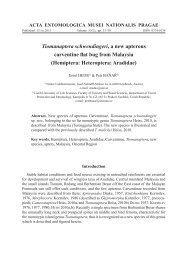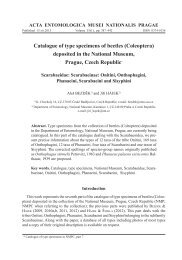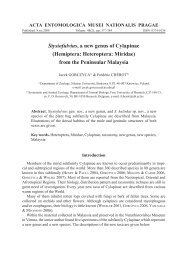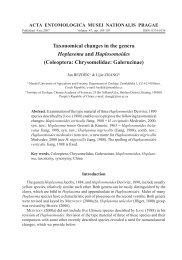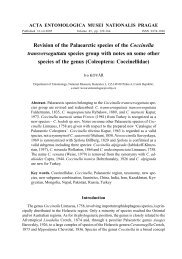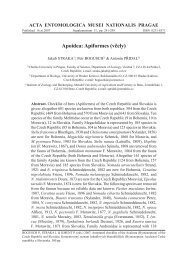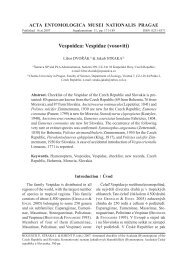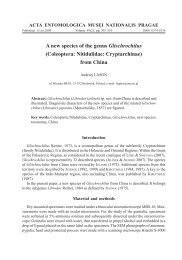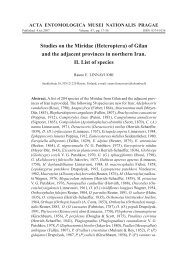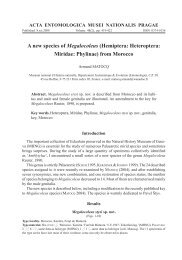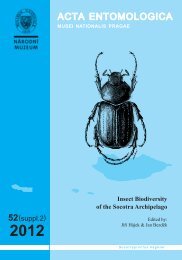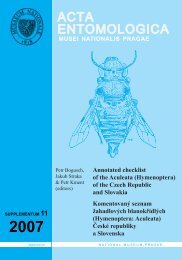ACTA ENTOMOLOGICA MUSEI NATIONALIS PRAGAE
ACTA ENTOMOLOGICA MUSEI NATIONALIS PRAGAE
ACTA ENTOMOLOGICA MUSEI NATIONALIS PRAGAE
You also want an ePaper? Increase the reach of your titles
YUMPU automatically turns print PDFs into web optimized ePapers that Google loves.
432<br />
GHAHARI et al.: Annotated catalogue of the Iranian Alydidae<br />
Subfamily Leptocorisinae Stål, 1872<br />
Genus Leptocorisa Latreille, 1829<br />
Leptocorisa oratoria (Fabricius, 1794)<br />
Material examined. ISFAHAN: Isfahan (1588 m), July 1999, 1 �, H. Masjedian leg., D. L. Carpintero det. New<br />
record for Iran.<br />
General distribution. China, Japan, Oriental and Australasian Regions (DOLLING 2006).<br />
Comment. Both the adults and nymphs feed on grains at the milking stage (especially wheat<br />
and barley). Feeding causes empty or small grains during the milking stage. At the soft or<br />
hard dough stage, feeding causes deformed or spotty grains. The grains become dark as a<br />
result of spilling of endosperm. The spillage becomes a medium for fungal infection. Since<br />
the eggs of Leptocorisa spp. are parasitized by Gryon spp. (Scelionidae) and Ooencyrtus<br />
spp. (Encyrtidae) (CORBETT 1930, AKBAR 1958, AHMAD 1965, REISSIG et al. 1986), and some<br />
specimens of Gryon sp. (near to G. nixoni Masner, 1965) and Ooencyrtus sp. were collected<br />
from Isfahan, they can probably be efficient parasitoids of L. oratoria in this region.<br />
Discussion<br />
The results of the present paper indicate that 21 species of 11 genera were identified from<br />
Iran so far. Iran is a large country incorporating various geographical regions and climates<br />
(Fig. 1), and we suppose that a large number of species remain to be discovered. To find<br />
new species and distributional records, more studies should be conducted on the Alydidae<br />
in all regions of Iran.<br />
Also, the host associations of Iranian alydids are poorly known. The majority of the alydine<br />
species in Iran are found on legumes. Riptortus linearis is a pest of legumes but it is also<br />
known from several unrelated host plants. The host associations of the Leptocorisinae are<br />
better known. SANDS (1977) provided a detailed account of the biology of the Leptocorisa<br />
species in Papua New Guinea outlining their life histories, host associations and crop damage.<br />
The works conducted on host plants of the world Alydidae are rather limited (SCHAEFER 1980).<br />
Determining of host plants and natural enemies (especially parasitoids) of alydids in Iran and<br />
also other regions of the world can be the important and invaluable research work.<br />
Acknowledgements<br />
The authors are indebted to Petr Kment (National Museum, Prague, Czech Republic) for<br />
preparing the manuscript for publishing and sending several necessary papers. We thank to<br />
C. W. Schaefer (University of Connecticut, USA), late I. M. Kerzhner (Russian Academy<br />
of Sciences) and H. Sakenin (Ghaemshhahr Islamic Azad University) for invaluable help<br />
in progress of the project. The research was supported by Islamic Azad University (Tehran<br />
Science and Research Branch), Consejo Nacional de Investigaciones Científicas y Técnicas<br />
(CONICET, Argentina) and Museum Requien, France.



